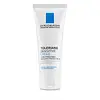What's inside
What's inside
 Key Ingredients
Key Ingredients

 Benefits
Benefits

 Concerns
Concerns

 Ingredients Side-by-side
Ingredients Side-by-side

Water
Skin ConditioningGlycerin
HumectantSqualane
EmollientDimethicone
EmollientZea Mays Starch
AbsorbentNiacinamide
SmoothingAmmonium Polyacryloyldimethyl Taurate
Emulsion StabilisingMyristyl Myristate
EmollientStearic Acid
CleansingCeramide NP
Skin ConditioningPotassium Cetyl Phosphate
EmulsifyingGlyceryl Stearate Se
EmulsifyingSodium Hydroxide
BufferingMyristic Acid
CleansingPalmitic Acid
EmollientCapryloyl Glycine
CleansingCaprylyl Glycol
EmollientXanthan Gum
EmulsifyingWater, Glycerin, Squalane, Dimethicone, Zea Mays Starch, Niacinamide, Ammonium Polyacryloyldimethyl Taurate, Myristyl Myristate, Stearic Acid, Ceramide NP, Potassium Cetyl Phosphate, Glyceryl Stearate Se, Sodium Hydroxide, Myristic Acid, Palmitic Acid, Capryloyl Glycine, Caprylyl Glycol, Xanthan Gum
Water
Skin ConditioningPropanediol
SolventGlycerin
HumectantCaprylic/Capric Triglyceride
MaskingHelianthus Annuus Seed Oil
EmollientLecithin
EmollientSodium Acrylates Copolymer
Isostearyl Isostearate
EmollientCetearyl Ethylhexanoate
EmollientPhytonadione Epoxide
AstringentArnica Montana Flower Extract
MaskingHesperidin Methyl Chalcone
AntioxidantMorus Alba Root Extract
BleachingDipeptide-2
Skin ConditioningPalmitoyl Tetrapeptide-7
Skin ConditioningBiosaccharide Gum-1
HumectantTocopherol
AntioxidantBisabolol
MaskingTocopheryl Acetate
AntioxidantButylene Glycol
HumectantSteareth-20
CleansingGlyceryl Undecylenate
EmollientGlyceryl Caprylate
EmollientDisodium EDTA
Potassium Sorbate
PreservativeBenzyl Alcohol
PerfumingPhenoxyethanol
PreservativeChlorhexidine Digluconate
AntimicrobialWater, Propanediol, Glycerin, Caprylic/Capric Triglyceride, Helianthus Annuus Seed Oil, Lecithin, Sodium Acrylates Copolymer, Isostearyl Isostearate, Cetearyl Ethylhexanoate, Phytonadione Epoxide, Arnica Montana Flower Extract, Hesperidin Methyl Chalcone, Morus Alba Root Extract, Dipeptide-2, Palmitoyl Tetrapeptide-7, Biosaccharide Gum-1, Tocopherol, Bisabolol, Tocopheryl Acetate, Butylene Glycol, Steareth-20, Glyceryl Undecylenate, Glyceryl Caprylate, Disodium EDTA, Potassium Sorbate, Benzyl Alcohol, Phenoxyethanol, Chlorhexidine Digluconate
 Reviews
Reviews

Ingredients Explained
These ingredients are found in both products.
Ingredients higher up in an ingredient list are typically present in a larger amount.
Glycerin is already naturally found in your skin. It helps moisturize and protect your skin.
A study from 2016 found glycerin to be more effective as a humectant than AHAs and hyaluronic acid.
As a humectant, it helps the skin stay hydrated by pulling moisture to your skin. The low molecular weight of glycerin allows it to pull moisture into the deeper layers of your skin.
Hydrated skin improves your skin barrier; Your skin barrier helps protect against irritants and bacteria.
Glycerin has also been found to have antimicrobial and antiviral properties. Due to these properties, glycerin is often used in wound and burn treatments.
In cosmetics, glycerin is usually derived from plants such as soybean or palm. However, it can also be sourced from animals, such as tallow or animal fat.
This ingredient is organic, colorless, odorless, and non-toxic.
Glycerin is the name for this ingredient in American English. British English uses Glycerol/Glycerine.
Learn more about GlycerinWater. It's the most common cosmetic ingredient of all. You'll usually see it at the top of ingredient lists, meaning that it makes up the largest part of the product.
So why is it so popular? Water most often acts as a solvent - this means that it helps dissolve other ingredients into the formulation.
You'll also recognize water as that liquid we all need to stay alive. If you see this, drink a glass of water. Stay hydrated!
Learn more about Water